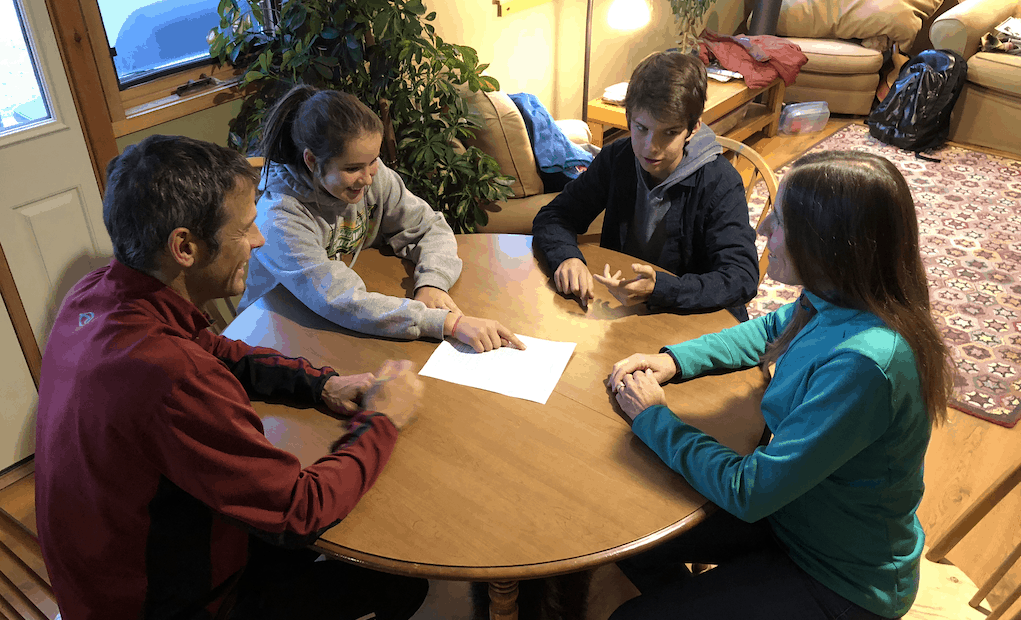Family Technology Pact: Why You Need One and the Hidden Benefits

By: Rachel Wigglesworth
I will admit: my kids’ use of digital media is a trigger for me. I’m not sure why – there were periods in my childhood where I watched 4 hours of TV a day. Still, I see my kids walking around the house or sitting on the couch plugged into their devices and it’s all I can do to hold back my judgment and nagging. What I’ve come to realize with much practice and patience is twofold: 1) our children’s use of technology affords them many learning experiences beyond what is immediately at hand, and 2) having clear and firm boundaries around their use preserves the relationship I have with my kids. Ok… there’s a third: I have to keep my use of digital media in check too.
There is no doubt that technology use affords us many benefits. Our devices can open up our world and expand our possibilities within seconds. They can also unwittingly expose us and our children to potentially damaging images, ideas and social contexts such as pornography, cyberbullying and violent images. On top of that, our devices with apps, games, social media and instant replay videos are designed to be addictive in nature. Every notification from the device sends our brain a hit of dopamine, which activates our reward system leaving us craving for more.
When I see my kids lounging on the couch in a technology-induced hypnotic state, I often find myself screaming inside: SHOULDN’T THEY BE DOING SOMETHING MORE PRODUCTIVE? Playing, getting outside, helping out in the house, taking initiative and responsibility, thinking about others, engaging in face to face interaction, working on some creative endeavor… The list could go on. It’s all I can do (and often not do!) to keep my mouth shut and remember what we have all heard about the importance of balance. To that end, my husband, two kids, and I sat down (that’s us in the feature image) to create guidelines for family media use. It took many iterations and finally ended in what we call “The Technology Pact”.
Before I go into details about creating a Technology Pact I want to note that this will look different for every family. There is no right or wrong here. Each family’s Pact will be based on individual family culture: values, goals, beliefs, desires, personalities and the child’s age. That’s the beauty of families – we can be free to be ourselves and come up with family guidelines based on who we individually are. Thus while I am sharing with you what we came up with for our family, which is imperfect at best, what you come up with in your family may be wildly different – and that’s OK!
A crucial piece of our Technology Pact is that we co-created it as a family. It would have been easier for my husband and me to write the Technology Pact ourselves. After all, I like the rules that I would come up with. However, what I’ve learned over time is that any agreement we have with our kids is not going to work unless the kids participate in the process. Despite my urges to frustratingly announce that we NEED TO REVISIT OUR TECHNOLOGY RULES in the heat of their use (which may have happened on occasion), as a family we found a time that worked for everyone to sit down and calmly discuss our perspectives, observations, and values.
Our Technology Pact starts with what we believe about technology use:
- that we should be able to use technology;
- that technology use should be in balance with other things we do in life; and
- that we all need to learn to self-monitor to achieve this balance.
For me, the most important of these beliefs is the last – our ability to self-monitor. It speaks to my first realization alluded to above that our children’s use of technology affords them many learning experiences beyond what is immediately at hand. Most important for me is that it teaches us the important executive functioning skills of self-control and impulse control. Among other positive outcomes, research suggests that self-control is more important than academic talent in predicting academic success.
In creating our Pact we found that discussions around definitions and how we use digital media were necessary. We created and agreed to screen free times – times when using our devices was off limits. For example, eating dinner together is an important time to connect for our family – thus no one is allowed to check their phones during this time. If a phone dings, we ignore it. How liberating! We built in caveats for “emergencies”, such as being in touch with a family member who is not at home, or solidifying a plan that is set to happen immediately after dinner; we want to allow for some flexibility and are committed to not take advantage of these caveats.
Together we came up with time limits on daily use. To do this we had long discussions about the definition of “use”. That may sound silly – having a screen in front of you is use, right? True, and we decided we didn’t need to limit use if that use entailed communicating with friends. After all, I spent hours on the phone talking to friends as a kid. Kids today communicate differently using text and social media (note my withholding of judgement!), and we decided that beyond excessive social communication, there was no need to limit that kind of use.
To address the balance issue, we adopted ideas used by other families I found on the web. We decided that the kids needed to engage in certain activities before they used their allotted screen time for the day. Thus no devices are to be used before household responsibilities are completed and offers to help are made. We also created requirements for reading, creative time and outdoor/ physically active time.
My husband and I compromised with the kids in some realms – they wanted to be able to check their phones for a few minutes right when they got home so they could be up on any recent social communication. We were fine with that. While I am a firm believer in no screens an hour before bedtime, they wanted to try being given the privilege to use their phone up to 15 minutes before bedtime – so we created a pilot program with this plan to be reevaluated. We allowed for exceptions to our agreements and wrote those directly into our Pact.
Finally, we came up with agreements around self-monitoring our use, how we interact with each other personally when we are using our devices, and individually set goals around our use.
It is always a work in progress. For example, under the category of safety, I just noticed that I’d like to add something about using our devices while driving. Our kids will be driving soon, and my husband and I could make some improvements on how we use our devices while in the car. Finally, we decided that if our kids became emotional in regards to digital media use, this indicated to us that our kids weren’t ready to handle the responsibilities that go along with using their devices. We felt that our kids needed to show us that they could maturely handle stopping their use at the allotted time without us micromanaging and without our kids melting down or begging for more time.
We are by no means perfect at this. I am not always consistent enough in holding my kids accountable to our agreements. This can lead to a slippery slope of my kids not self-monitoring. It is a work in progress.
Benefits of our Pact Beyond Regulating Digital Media Use
One of the most important jobs we have as parents is to teach our kids the skills they need for when they leave the home. Family agreements, such as those surrounding technology use, are simply a conduit for such teaching. Developing self-control around a device that is designed to fight you in that endeavor every step of the way is not easy. The part of our brain that controls self-control is underdeveloped for our younger children, and these skills temporarily diminish during the early teens. Our kids need our support.
The skills used to create the Technology Pact can be another learning experience beyond that of the immediate education technology can provide. When we were able to sit down and co-create our Pact, together we were able to talk about our desires, fears and beliefs surrounding technology use; really listen to the other’s perspective even if we didn’t agree with it; and sit through the discomfort of differing opinions, speak up for our beliefs and find compromise in a plan that worked for everyone. Learning how to negotiate and hear another’s perspective without dissolving into an emotional mess or raging anger is all too important in today’s world. What a better way to practice these skills in low stakes moments and in the safety of home.
My second realization has to do with what I’ve learned from parent educator and author Vicki Hoefle: having strong boundaries around limits with our children helps preserve the relationship. If I have a clear limit with my child that we have co-created, and if I am strong enough to follow through with the limit, then everything becomes clear. There is no need to nag and no need for push-back, thus no need to engage in a power struggle. If we are all on the same page and the rules are known, if the kids break the rules, they know the repercussions, and they take responsibility for their actions.
5 Tips for Upholding your Technology Pact
Creating and holding to a Technology Pact sounds easy in writing. It’s really tough in reality. Our kids are going to push back. Here are some ideas for how to work through those times:
- We as parents need to be consistent in a firm and kind way. This means maintaining limits with understanding and empathy. It also means that we have to manage our strong and reactive emotions as well. Not an easy feat, but with practice completely possible.
- Help your child develop the skills of self-regulation. If you find your child isn’t able to self-regulate – that you are constantly nagging and engaging in power struggles around media use, then that tells you your child needs some support. If your child isn’t able to hold to the agreement, then use a predetermined and agreed upon natural consequence. It is OK to take away the device for a set time if your child can’t independently stop her or his use. As parents, we have to be strong enough to handle the potential emotional fallout – a conversation for another time!
- Help your children be mindful of their use. How are they engaging with their world as a result of their use? How do they feel before, during and after their use? Ask them these questions.
- Allow your children to see the natural consequences of overindulging in digital media. Are they unable to get their homework done, take care of their responsibilities in the home (which I highly advocate that they have), interact with others face to face, etc? I remember becoming somewhat addicted to the game “asteroids” when I was in college to the point that it made me late for soccer practice. Soccer was my life at the time! I soon realized that I had to reign myself in and find a balance so the game wasn’t interfering with what was important in my life.
- Consider the quality as well as the quantity of digital media use. Is it promoting healthy values and lifestyle or not? If not, have a conversation with your child about it. You may still agree that some of the content is OK to use, and you are talking about the values it is espousing.
Above all, maintaining a strong, mutually respectful relationship with your child is essential. Let your child know you value his or her opinion. While we did not grow up where screens were so accessible, we need to acknowledge that this is an important part of our children’s world. Hear their arguments. Compromise where you can. This kind of back and forth will show your children you value their input, and will go miles in helping them feel valued in the world.
Rachel Wigglesworth has an M.Ed. in Parent and Family Education and is the founder and parent educator/coach at www.GrowingGreatFamilies.org. She provides guidance to parents and caregivers through classes, workshops, and individual sessions. You can send an email to Rachel Wigglesworth or find her on Facebook.
For more, see:
- A Parent’s Call to Action: Leveraging Personalized Learning for Your Child
- Parenting 2.0: Teach Tech and Empathy, Fight for Equity
- How to Talk to Parent’s About Your School’s EdTech
- Why An Anti-Screen Family Has Gone Blended
Stay in-the-know with all things EdTech and innovations in learning by signing up to receive the weekly Smart Update.





0 Comments
Leave a Comment
Your email address will not be published. All fields are required.